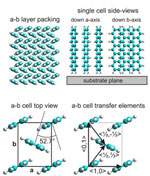Understanding Nature's Assembly of Molecules to Improve Tomorrow's Electronics
summary written by Raven Hanna
Nothing seems to move as fast as the field of consumer electronics. A browse through a technology store reveals the dizzying array of space-age -seeming products like flat screen TVs, touch screen phones, and mp3 players. A new development in electronics is on the horizon, one that may bring us roll-up flat screens and high-definition display clothing. These will be made possible using the thin and energy efficient organic light emitting diodes (OLEDs), which are based on organic semiconductor technology. Both a desire for less expensive, more convenient technologies and a concern for energy conservation have heightened interest in the field of organic semiconductors.
Organic semiconductors have the properties of silicon-based semiconductors, found ubiquitously in the diodes, transistors, and chips that run our modern, computerized devises, but they are made from organic materials. They have the potential to be far less expensive to make than the classic silicon versions and can be made flexible and lighter weight over large areas. One of the most popular type of organic semiconductor is made from thin films of pentacene, a long, polycyclic aromatic hydrocarbon molecule. In this form, electrical current flows primarily through the first few layers of the pentacene material.
A research group led by Zhenan Bao of Stanford University collaborating with SSRL scientists Stefan Mannsfeld and Michael Toney has used Beam Line 11-3 to investigate the structure and properties of single molecular layers of pentacene. Using grazing incidence X-ray diffraction (GIXD) and newly developed modeling tools, they determined for the first time the precise structural arrangement and the orientation of the molecules from the weakly-diffracting films.
The researchers discovered that the molecules stand upright on the substrate plane. Looking down at the plane, the molecules pack in a herringbone pattern. They calculated that this orientation of pentacene leads to the material's electronic properties, which exceed those of single crystalline pentacene. This research demonstrates that determination of the structural properties of a single layer of organic semiconductor molecules is possible and that this information can yield valuable insight into the function of these molecules. This work was published in the March issue of the journal Advanced Materials.
To learn more about this research see the full Scientific Highlight
Precise Structure of Pentacene Monolayers on Amorphous Silicon Oxide and Relation to Charge Transport, S.C.B Mannsfeld, A. Virkar, C. Reese, M.F. Toney, Z. Bao, Adv. Mat. 21, 2294 (2009).


